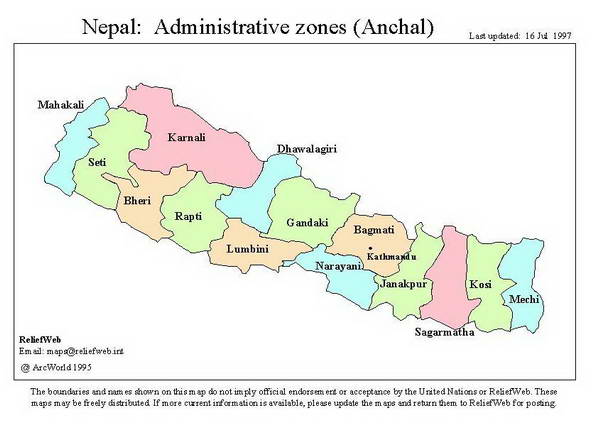|
Page 4 of 7
System of the Government:
Government type: Parliamentary Democracy
Capital: Kathmandu
Administrative Divisions: 14 zones (Anchal, singular and plural); Bagmati, Bheri, Dhawalagiri, Gandaki, Janakpur, Karnali, Kosi, Lumbini, Mahakali, Mechi, Narayani, Rapti, Sagarmatha, Seti
Independence: always been a soverign independent country, 1768 (unified by Prithvi Narayan Shah)

Constitution: 9 November 1990
Legal system: based on Hindu legal concepts, and English common law; has not accepted compulsory ICJ jurisdiction
Suffrage: 18 years of age; universal
Flag and National Emblems:
The national flag of Nepal consists of two juxtaposed triangular figures with crimson coloured base and deep blue borders, there being a white emblem of crescent moon and a white emblem of sun in the lower part. Rhododendron Arboream is the national flower, Crimson is the national colour, Cow is the national animal and the Danphe (Lophophorus) is the national bird.
Economy:
GDP: purchasing power parity$26.2 billion (1998 est.)
GDP real growth rate: 4.9% (1998 est.)
GDP per capita: purchasing power parity$1,100 (1998 est.)
GDP composition by sector:
Agriculture: 41%, Industry: 22%, Services: 37% (1997)
Population below poverty line: 42% (1995-96 est.)
Household income or consumption by percentage share: lowest 10%: 3.2%, highest 10%: 29.8% (1995-96)
Inflation rate (consumer prices): 7.8% (1998 est.)
Labor force: 10 million (1996 est.)
Labor force by occupation: agriculture 81%, Services 16%, Industry 3%
Unemployment rate: NA%; substantial underemployment (1996).
Budget: Revenues: $536 million / Expenditures: $818 million, including capital expenditures of $NA (FY96/97 est.)
Industries: tourism, carpet, textile; small rice, jute, sugar, and oilseed mills; cigarette; cement and brick production
Industrial production growth rate: 14.7% (FY94/95 est.)
Electricity production: 1.032 billion kWh (1996)
Electricity production by source:
Fossil fuel: 3.1%, hydro: 96.9% , other: 0% (1996)
Electricity consumption: 1.013 billion kWh (1996)
Electricity exports: 89 million kWh (1996)
Electricity imports: 70 million kWh (1996)
Electricity: 220V, 50 Hz
Agriculture products: rice, corn, wheat, sugarcane, root crops; milk, water buffalo meat
Exports: $394 million (f.o.b., 1997), but does not include unrecorded border trade with India
Exports commodities: carpets, clothing, leather goods, jute goods, grain
Export partners: India, US, Germany, UK
Imports: $1.7 billion (c.i.f., 1997)
Imports commodities: petroleum products 20%, fertilizer 11%, machinery 10%
Imports partners: India, Singapore, Japan, Germany
Debt external: $2.4 billion (1997)
Economic aid recipient: $411 million (FY97/98)
Currency: 1 Nepalese rupee (NR) = 100 paisa
Fiscal year: 16 July-15 July
Health risks: Altitude sickness, hepatitis A, malaria (low-lying areas only), meningococcal Meningitis (Kathmandu Valley region) and typhoid
Climate: Nepal has four major seasons - The winter (December - February), Spring (March - May), Summer (June - August), and Autumn (September - November).
Literacy: total population: 27.5%, though in urban areas it is very higher and in remote areas often as low as 10% and under. Male: 40.9% / Female: 14% (1995 est.)
Currency and Foreign Exchange: Nepali rupee notes come in Rupee1, RS.2, 5, 10, 20, 50, 100, 500, & 1000 denominations. Coins come in 5, 10, 25P, RS.1, RS.5 denominations. 1 US$ equals 63 Nepali Rupee (NRs) (January 2008), 1 SFR (Swiss Franc) equals 57 NRs (January 2008). Fixed exchange rate between the Indian Rupee and the Nepali Rupee.1 Indian Rupee equals 1.6 NRs.
|





